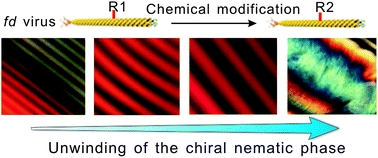Filamentous viruses of similar molecular and subunitary structure can form either a liquid crystalline nematic phase or a chiral nematic – also called cholesteric – phase, which is an elegant example of how self-organization of nanorods, with otherwise similar properties, can be affected by only subtle differences of surface properties and of the arrangement of the constituent subunits. In this work, we studied the influence of viral surface properties on the self-assembly of rod-like fd virus suspensions into the chiral nematic phase. For this purpose, the filamentous fd virus has been subjected to various chemical modifications on its capsid proteins: several organic molecules of different sizes and structures, including two popular fluorescent dyes (fluorescein and rhodamine), were coupled to the surface amino groups of the virus. The resulting chemically modified viruses still form a cholesteric phase in an aqueous suspension, but with a lower helicity compared to suspensions made of wild-type fd viruses. The degree of unwinding of the helical periodicity (or cholesteric pitch) depends on the structure of the labeled molecules. In addition, the chemically modified viruses exhibit a well-defined first order phase transition between the isotropic liquid and the liquid-crystalline state. Besides these modifications targeting the amino groups, the surface carboxyl groups were coupled with amino compounds so that the surface charge of fd viruses was reversed from negative to positive. The resulting particles can only form a nematic phase without any macroscopic helicity. These results suggest that inter-particle interactions, together with the intrinsic chirality of the virus, play an important role in the origin of the helical twist in the cholesteric phase.

You have access to this article
 Please wait while we load your content...
Something went wrong. Try again?
Please wait while we load your content...
Something went wrong. Try again?


 Please wait while we load your content...
Please wait while we load your content...